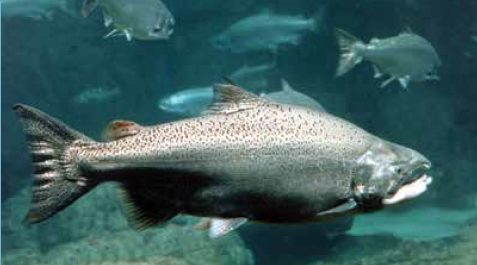Q/A: Of Fish and Flows: Delta Conveyance and the Health of Delta Fisheries
Sacramento River winter-run chinook salmon
The Sacramento-San Joaquin Delta is one of the largest estuaries in North America, providing habitat for around 500 plant and animal species, including about 50 species of fish. Approximately two‑thirds of California's salmon pass through the Delta on their way upstream to spawn. Delta waters are also home to the endangered Delta smelt, which is widely seen as an indicator species for the overall health of the Delta's ecosystem. Consequently, questions about how the Delta Conveyance Project would take into account the needs of the fish in the Delta are often on people's minds.
The Delta Conveyance Deep Dive video series recently featured two of the project’s leading experts on aquatic life in the Delta for a discussion of Delta fisheries and how the health of fish populations would influence the construction and operation of new conveyance infrastructure in the Delta.
Gardner Jones, a program manager in the Delta Conveyance office, is responsible for the Delta Conveyance Fisheries Analysis and Endangered Species Act compliance. He has worked exclusively on Delta fisheries and related planning since joining DWR in 2006.
Chris Geach is a senior environmental scientist in the Division of Integrated Science and Engineering at DWR working on the development of the Delta Conveyance Project and associated environmental compliance and permitting efforts. He has worked exclusively on Delta environmental planning since joining DWR in 2013.
DWR’s Pat Clark hosted the interview.
PAT CLARK: I think many of our viewers today will be aware that it's because of the many environmental concerns that the quantity and quality of water in the Delta is highly regulated. Gardner, could you briefly explain the existing Delta operations criteria?
GARDNER JONES: Sure, Pat. At a high level, the way I think of it is that there's really numerous layers of existing Delta regulations that control water operations, including those established by the State Water Resources Control Board. There are also regulations associated with activities permitted through federal and state fish agencies to regulate State Water Project diversions. Notable existing Delta regulations include but aren't limited to the allowable exports by the state and federal water projects.
There are also Delta outflow requirements to manage salinity, existing flow requirements like for Old and Middle rivers for example, and export restrictions based on state and federal Endangered Species Acts permits. These are intended to minimize potential impacts on listed fish species like Delta smelt, winter run chinook salmon and others, associated with the Central Valley and State Water Project south Delta water operations.
PC: Thanks. Now let's move on to how the Delta Conveyance Project would fit into or change the current system. Let's start with a key feature we've heard a lot about in previous episodes and that's dual conveyance. Can you remind us, Chris, what that means and explain why it's such a crucial feature of the project?
CHRIS GEACH: Dual conveyance simply means that we have a choice of where we divert water, either from the current south Delta facilities or the new north Delta diversion facilities proposed under the Delta Conveyance Project. This is very useful because it gives us flexibility, especially during high Sacramento river flows like during large storm pulses where we could divert water at the new intakes with no or minimal effects on the aquatic environment. This will reduce or avoid south Delta entrainment potential to fish (like Delta smelt for example) from occurring in the central southern Delta, which can be a concern during these flow conditions. Alternatively, during periods where flows are low or vulnerable fish are more concentrated near the north Delta facilities, existing south Delta facilities would be relied upon. Overall, through intelligent investment in State Water Project facilities, new state‑of‑the‑art water intakes in the north Delta would improve the ability to divert water while reducing potential rerouting concentration and handling of fish as well as exposure to increased levels of predation that can occur at the existing south Delta facilities. Proposed fish screen technology, as well as operating criteria, will further minimize potential effects of diverting water on the Delta fish community.*
PC: So, what would this look like in real, practical terms, Gardner? How would it change the operations criteria?
GJ: Good question, Pat. The Delta Conveyance Project proposes new north Delta diversions or NDDs with state‑of‑the‑art intake technology as well as rules for operations that we call operating criteria. Conceptually, these rules are designed with layers of restrictions to minimize potential impacts to fish and the aquatic ecosystem. While the proposed NDD intakes might have a capacity of 6,000 cubic feet per second, the operating rules would limit actual diversions based on factors like hydrologic conditions and fish presence. These layers of operating criteria are informed by a growing understanding of fish biology and behavior as well as the Delta ecosystem as a whole. They're also intended to function at different geographic scales. So, at the overall Delta scale, the project is designed to integrate with existing facilities and operational regulations like those noted earlier, say for outflows. At the scale of the lower Sacramento River and intake reach, we have developed a number of operating rules to minimize potential impacts, including bypass flow criteria. The bypass flow criteria are the main rules governing NDD operations. They set restrictions on the amount of Sacramento River flow that can be diverted at the NDD. The flow remaining in the river and bypassing the diversions are intended to protect survival of fish like Chinook salmon and Delta smelt that migrate through the intake region through the Delta.
*The technology of fish screens will be the subject of the next episode of Delta Conveyance Deep Dive.
